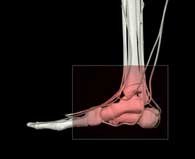Ankle Impingement
When a bony growth at the back or front of the ankle bone limits the ankle movement, this is known as an ankle impingement. There are two types of ankle impingement. It is either a posterior impingement where the back of the ankle is affected or an anterior impingement where the front of the ankle is affected. What type it is will depend on where the bony growth is. Ankle sprains that do not heal properly will bring about an impingement as tissue in the ankle joint can become stuck amongst the bones in the ankle.
In a posterior impingement, pain is generally felt at the back of the ankle. The bottom part of the fibulabone will feel sore and sensitive. When the foot is pointed downwards (plantar flexion) when moving or standing on your tip toes will probably be very painful. Bony growth on the shin bone and heel bone will show up on an x-ray. Ballet dancers are more likely to suffer from posterior impingement.
In an anterior impingement, pain is usually felt at the front of the ankle and sometimes at the side of the ankle too. This pain generally continues even after an ankle sprain has healed. The ankle may feel like it’s giving way under you due to weakness, this can make the foot point upwards (dorsi flexion). A bad ankle sprain or an ankle that is repeatedly getting sprained can cause anterior impingement. This is due to the ligaments becoming dense and getting stuck in between the talus and tibia bones. When torn ligaments begin to heal, the body can form too much scar tissue. This is around the ankle, at the side and at the front. This is known as a meniscoid lesion.
To treat anterior and posterior impingement, a doctor may prescribe anti-inflammatory tablets. Ice or cold therapy can be used to ease inflammation and lesson pain. It is also important to rest for at least four weeks to aid recovery. If these do not help then surgery may be required.

